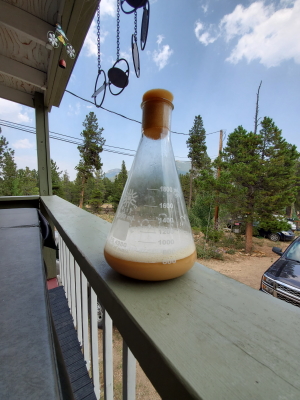Yeast Starters
After a spirited debate regarding the benefits of yeast starters with a good friend and fellow homebrewer, I have been persuaded to complete yeast starters for my brews (the strongest point in my friend's argument for yeast starters was sending me a yeast starter kit for my birthday).
I won't go into the gory details of the arguments for or against. I had never previously experienced any issues with pitching yeast directly to the wort, and with local yeast labs making yeast available shortly after production and with high cell counts, it may be a step that could be skipped. However, yeast starters are easy enough to do, are recommended for all grain recipes, and I have to admit that I have definitely witnessed a signicant decrease in the time fermentation begins when using yeast starters.

Yeast Starter Steps
I have been using the following steps as they were outlined in the yeast starter kit that my friend so generously gifted me on my birthday several years ago.
- Start by bringing your yeast package to room temperature
- Mix 1/2 Cup of DME (I've been using a light DME) to 650 ml of water
- Bring to a boil and boil for 15 minutes
- During the boil, sanitize your flask (or other yeast starter container), stopper, yeast pack, scissors, funnel, thermometer, and any other equipment that you are using that will come in contact with this mini wort.
- Cool this wort to your targeted fermentation temperature
- Pitch the yeast and shake or swirl the flask or other yeast starter container to aerate
- Allow to ferment for at least 12 hours and pitch into your main brew wort
Rehydrating Dry Yeast
An additonal question regarding yeast that comes up is whether to direct-pitch or rehydrate dry yeast. A recent article I've read in the September 2019 (Vol. 25, No. 5) issue of Brew Your Own concludes that while there is nothing negative about rehydrating dry yeast, with the improvements in dry yeast production there is no longer the same need to do it for most beer styles as there used to be. Fermentis conducted a study of fermentation performance for their yeast strains and found no significant difference in pitching Fermentis homebrewing strains directly vs. conducting a rehydration process. A synopsis of this study can be found at Brewing With E2U™ No More Rehydration Needed.
This article from Fermentis does recommend the following steps for direct pitching dry yeast:
- Fill the fermenter with 1/3 of the wort volume (up to the top of the CKT cone) at a temperature of 69.8-84.2 °F
- Sprinkle the active dry yeast cells directly in the fermenter
- Add the remaining 2/3 of the volume of wort at fermentation temperature to allow for mixing of yeast and wort.
Other Yeast Notes
Always have backup yeast sachets
Always have an extra sachet or two of dried yeast that can be pitched on a moment's notice in case the first pitch of yeast for some reason fails on you. If you are not seeing any signs of yeast activity within 48 hours of the initial pitch of yeast, it's time to go to the backup. Keep a favorite strain and keep the backup rotating through at regular intervals.
